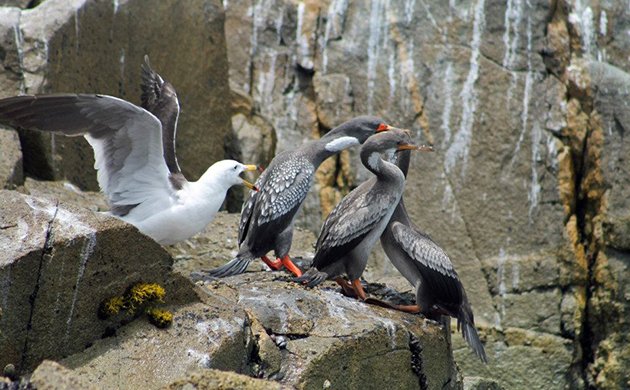
Kleptoparasitismis is a word that just means parasitism by theft. With birds, this happens when one takes prey or other food caught or collected by another. Klepstoparasitism seems to be more prevalent among birds associated with water; those unable to dive often take food from those able to catch their food underwater.
Some birds are opportunistic thieves, and others make a living at it. Skuas, Jaegers and Frigatebirds come to mind; they can pick up food from the surface of the water, but can’t dive. They often supplement their diets by stealing food from others.
Frigatebirds are perhaps the biggest of all thieves. They are known to hover over seabird nesting colonies, waiting for parent birds to return to the colony with their crops full of food. Frigatebirds will chase them until they regurgitate the food they brought for their young.
Frigatebirds don’t occur in the cold waters of the coast of Peru and Chile, but Band-tailed Gulls (Larus belcheri) have developed similar strategy. Instead of hovering, some gulls have set up territories within breeding colonies of Humboldt seabirds. Gulls will harvest/steal food from breeding birds within their territories and chase away other gulls ensuring that birds within their territories are not swarmed by multiple food thieves. It is, to some extent, a win-win situation.
The following photo sequence depicts a territorial Band-tailed Gull “collecting its protection service fee” from a Red-legged Cormorant nesting within the territory the gull protects on the Palomino Islands in front of Lima-Peru.
An adult Red-legged Cormorant (Phalacrocorax gaimardi) returns to feed its two young waiting among Inca Terns (Larosterna inca).

As the adult cormorant begins to feed its young, a Band-tailed Gull quickly appears in the scene as Inca Terns vacate the area. It is going to get rough here…
The Gull lands and assesses the situation waiting for the right time.
…then jumps into action. The Gull will take the fish out of the youngster beak as this retrieves it from the parent’s crop.
The gull almost acts as one of the youngsters and the adult does not seem to mind having it around.

The Gull is now eating what it just stole (on the left partially hidden). The adult cormorant leaves probably to get more food.
Then, the Gull seems to intimidate the youngsters by pushing them off the ledge; to show them who is in charge maybe? An Inca Tern hovers to see if there is any leftovers for her.

The Gull stands there in a threatening posture as one youngster leaves and the other seem to make an awkward retreat (on the bottom right corner).

And the story repeats itself multiple times during the day. This system of “fee” in exchange for protection from being overwhelmed by many thieves seems to work. The gulls breed their young and the cormorants raise their young successfully as shown by the size of the two young birds in the photos.
Photos: Courtesy of Eduardo Bucher – Mar Adentro Expeditions.















A pedantic nitpick; frigatebirdsbdo steal but typically don’t make a living from it, only a small proportion of their diet comes from theft, around five percent I think.
Duncan, I am not sure I said Frigatebirds make a living from stealing, but certainly in some places they rely on stealing a lot more than five percent of the time. Am sure this vary according to prevailing circumstances. I don’t know where the five percent study was conducted but I seem to remember having heard that number….it seems low though.